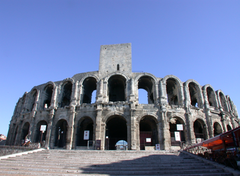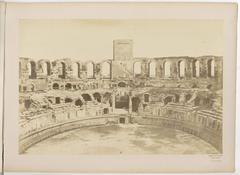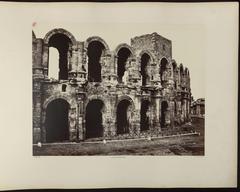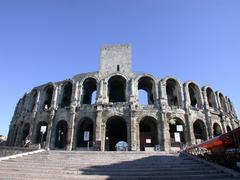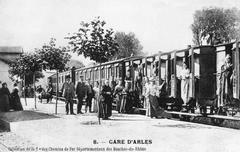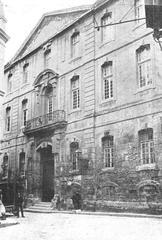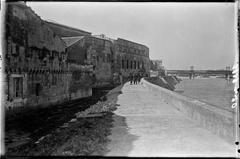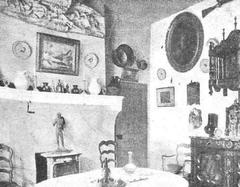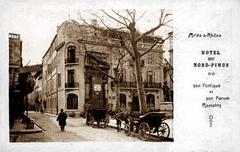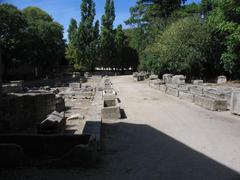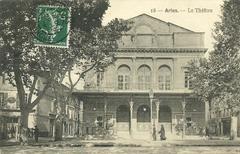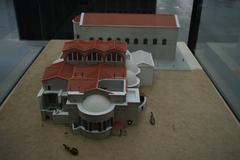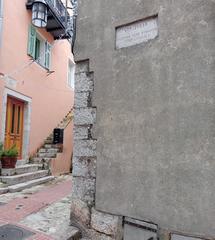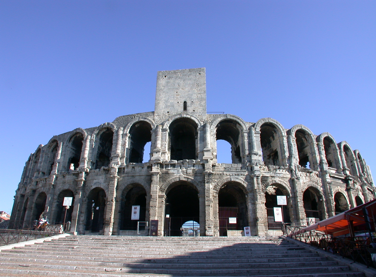
Visiting Arènes d’Arles: Tickets, Hours, History, and More
Date: 17/07/2024
Introduction
The Arènes d’Arles, a UNESCO World Heritage site, stands as a remarkable testament to the grandeur and resilience of Roman architecture. Situated in the historic city of Arles in southern France, this ancient amphitheater has captivated visitors for nearly two millennia. Built during the 1st century AD, the Arènes d’Arles initially served as a venue for gladiatorial combats and other public spectacles, accommodating over 20,000 spectators. Its elliptical design, constructed from local limestone, showcases the Romans’ architectural ingenuity and their ability to create structures that have withstood the test of time (UNESCO World Heritage Convention).
As the Roman Empire declined and the Middle Ages began, the amphitheater was repurposed into a fortress to protect against barbarian invasions. This transformation included the addition of towers and defensive walls, essentially converting the arena into a fortified village. By the Renaissance, the amphitheater drew renewed interest from artists and scholars, leading to restoration efforts that continued into the 19th century under figures like Prosper Mérimée (Roman Heritage - The Arènes d’Arles).
Today, the Arènes d’Arles serves as a versatile cultural venue, hosting bullfights, concerts, and various festivals. It remains a central part of Arles’ cultural identity, drawing thousands of tourists each year who come to explore its rich history and architectural splendor (French Ministry of Culture). This comprehensive guide will delve into the amphitheater’s storied past, its architectural significance, and essential visitor information, ensuring a memorable experience for all who visit.
Table of Contents
- Introduction
- Birth of an Amphitheater (1st Century AD)
- From Arena to Fortress (5th - 12th Century)
- Rediscovering the Roman Heritage (16th - 19th Century)
- A Stage for Bullfighting and Cultural Events (20th Century - Present)
- Tickets, Visiting Hours, and More
- A Living Monument
- Conclusion
- FAQ
The Roman Era - Birth of an Amphitheater (1st Century AD)
The Arènes d’Arles came into existence around the 1st century AD, during the peak of the Roman Empire. Constructed from local limestone, the amphitheater was a symbol of Roman power and a gift to the citizens of Arles, then known as Arelate. The structure, with its elliptical design and tiered seating, could accommodate over 20,000 spectators, a testament to the city’s significance within the Roman province of Gaul. (UNESCO World Heritage Convention)
Within the amphitheater’s walls, gladiators fought to the death, wild animals were pitted against both man and beast, and public executions were carried out. These spectacles, brutal as they may seem today, were integral to Roman society, offering entertainment, reinforcing social hierarchy, and serving as a tool for political propaganda.
The Middle Ages - From Arena to Fortress (5th - 12th Century)
With the decline of the Roman Empire and the rise of Christianity, gladiatorial combat and other forms of blood sport fell out of favor. The Arènes d’Arles, once a symbol of Roman entertainment, was repurposed to serve the needs of a changing society.
During the 5th century, as barbarian invasions swept across Europe, the amphitheater was transformed into a fortress. Towers were erected at strategic points, defensive walls were built, and the arena floor was filled with houses, creating a fortified village within the amphitheater’s walls. This transformation, driven by necessity, preserved the structure from complete destruction and allowed it to serve as a refuge for the people of Arles. (Roman Heritage - The Arènes d’Arles)
The Renaissance and Beyond - Rediscovering the Roman Heritage (16th - 19th Century)
The Renaissance brought with it a renewed interest in classical antiquity, and the Arènes d’Arles, once again, became an object of fascination. Artists and scholars flocked to Arles, drawn by the city’s Roman ruins and the amphitheater’s imposing presence.
However, the amphitheater remained a residential area, with houses, shops, and even a chapel occupying its interior. It wasn’t until the 19th century, under the direction of Prosper Mérimée, a prominent figure in the French preservation movement, that the process of clearing the arena began. Mérimée, recognizing the historical and architectural significance of the Arènes d’Arles, spearheaded the effort to restore the amphitheater to its former glory. (French Ministry of Culture)
The Modern Era - A Stage for Bullfighting and Cultural Events (20th Century - Present)
The 20th century marked a turning point for the Arènes d’Arles. With the arena cleared of its medieval and later additions, the amphitheater was once again able to host large-scale events. However, instead of gladiatorial combat, the Arènes d’Arles became a venue for bullfighting, a tradition deeply rooted in the culture of southern France.
Today, the Arènes d’Arles is renowned for hosting “Courses Camarguaises,” a bloodless form of bullfighting unique to the region. These events, held during the annual Feria d’Arles, draw thousands of spectators and are an integral part of the city’s cultural identity. Beyond bullfighting, the amphitheater also hosts concerts, theatrical performances, and other cultural events, showcasing its versatility as a venue. (Arles Tourist Office)
Visitor Information - Tickets, Visiting Hours, and More
For those planning to visit, here are some essential details:
- Visiting Hours: The Arènes d’Arles is generally open daily from 9 AM to 7 PM, but hours may vary by season. It’s recommended to check the official website for the most current information.
- Tickets: Entry tickets can be purchased online or at the entrance. Prices vary, with discounts available for seniors, students, and groups. Guided tours are also available for an additional fee.
- Special Events: The amphitheater hosts various events throughout the year, including bullfights, concerts, and festivals. Check the event calendar for upcoming events.
- Nearby Attractions: While in Arles, don’t miss other historic sites like the Roman Theatre, the Church of St. Trophime, and the Alyscamps. The city’s vibrant markets and charming cafes are also worth exploring.
- Accessibility: The Arènes d’Arles is partially accessible to those with mobility issues. It’s best to contact the venue ahead of time to discuss specific needs.
The Arènes d’Arles Today - A Living Monument
The Arènes d’Arles stands today as a powerful symbol of the passage of time and the evolution of human civilization. Its history, etched into its very stones, tells a story of gladiatorial combat, defensive fortifications, urban development, and cultural revival. As a UNESCO World Heritage site, the amphitheater is not only a remarkable feat of Roman engineering but also a testament to the enduring power of human history and the importance of preserving our shared cultural heritage.
Conclusion
Whether you’re exploring the ancient ruins, attending a lively cultural event, or simply soaking in the historical ambiance, the Arènes d’Arles offers a unique and enriching experience. Plan your visit today to witness this incredible monument firsthand. Don’t forget to download our mobile app Audiala for an enhanced guided tour, check out related posts, and follow us on social media for the latest updates and travel tips.
FAQ
Q: What are the Arènes d’Arles visiting hours?
A: The Arènes d’Arles is generally open daily from 9 AM to 7 PM, but hours may vary by season.
Q: How much do tickets to the Arènes d’Arles cost?
A: Ticket prices vary, with discounts available for seniors, students, and groups. Guided tours are available for an additional fee.
Q: Are there special events at the Arènes d’Arles?
A: Yes, the amphitheater hosts various events, including bullfights, concerts, and festivals. Check the event calendar for upcoming events.
Q: Is the Arènes d’Arles accessible to those with mobility issues?
A: The Arènes d’Arles is partially accessible. It’s best to contact the venue ahead of time to discuss specific needs.
Q: What other attractions are nearby?
A: Nearby attractions include the Roman Theatre, the Church of St. Trophime, and the Alyscamps, among others.
References
- Arènes d’Arles - Visiting Hours, Tickets, and Historical Insights, 2024 (UNESCO World Heritage Convention)
- Roman Heritage - The Arènes d’Arles, 2024 (Arles Tourist Office)
- French Ministry of Culture, 2024 (French Ministry of Culture)
- Exploring the Arènes d’Arles - History, Architecture, and Visitor Information, 2024 (Arles Tourist Office)
